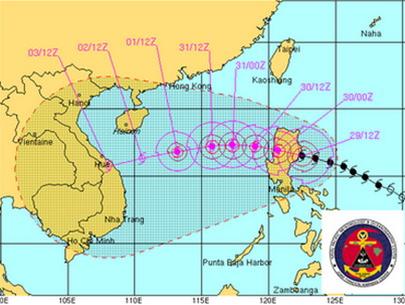Super Typhoon Cimaron enters the South China Sea
On the evening of October 29, Cimaron stormed into the southern island of Isabela Luzon (Philippines) with extremely strong winds.
The Philippine Meteorological Agency measured winds of up to 195km / hour (level 16), jerked 230km / hour (in the Beaufort wind scale, the last level was level 17 only to 220km / hour), Xangsane storm was the strongest. At level 16, 17. The US Naval Storm Warning Center (JWTC) measured wind speeds up to 260km / h, 315km / h jerks and officially called super typhoons.
The University of London's TSR observing network at midday also confirmed that Cimaron storm surpassed Cat 5 wind, the last level in the Saffir-Simpson wind scale of the Atlantic Ocean should be called super typhoon. The Chinese Meteorological Agency also called super typhoons when measuring wind speeds of up to 216km / h, and pressure of 915HPA (smaller than 920HPA is called super typhoon).

Photos of the US Navy forecast that on November 2, storms will hit Da Nang - Quang Ngai area (Photo: TTO)
The Philippine Meteorological Agency's forecast shows that super typhoon will continue to move in the direction of west and west northwest with a speed of 17km / hour. Forecast of other meteorological agencies said that today 30-10 super typhoons will cross Luzon island into the South China Sea and then move west and then between west and southwest. By 2-11 super typhoon will land in Da Nang - Quang Ngai area. However, when entering the East Sea due to the influence of the northeast monsoon and the temperature in the East Sea is not high, it does not meet the conditions, so the super typhoon will weaken quite a lot, the wind at that time only about 104-140km / hour ( level 11 - level 13).
* By the afternoon of October 29, through ICON means, Da Nang Border Guard had contacted 98 offshore fishing means with a total number of 561 people. The above vessels are currently engaged in fishing in the southern waters of the Tonkin Gulf, Hoang Sa, Truong Sa and Con Co. The number of ships that were prevented from leaving the sea was 56 with 420. However, according to Da Nang Border Guard, the number of unconnected offshore fishing boats is still quite large, because by this time more than 90% of Da Nang's offshore boats have departed since the storm of Xangsane.
* October 29 night, Cimaron storm - the strongest storm in the last eight years in the Philippines - has landed in the northern coastal area of the country with winds of 195km / hour, shocking over 230km / hour.
A witness in the town of Solana, in the province of Cagayan (northeastern Philippines) said some areas have lost power, heavy rain and terrible wind. Health and disaster prevention officials have asked people in lowland areas to evacuate upland areas.
KV - ĐN. - ATTRACTION
- Super Typhoon Haiyan enters the South China Sea
- Super typhoon on level 17 is entering the South China Sea
- In the next 24 hours, the mind of the super typhoon Haiyan enters the waters of Hue-Binh Dinh
- The 10 biggest storms recorded in history
- Nakri is probably the strongest storm since the beginning of the year in the South China Sea
- Vietnam may face new super typhoons
- Mangkhut super typhoon weakened into tropical depression on mainland China
- Super Typhoon Mangkhut jumped above level 17, accelerating into the South China Sea
- Direct update of the path of Typhoon Mangkhut
- Super typhoon Haiyan is about to land in Philippines
- Cimaron storm toward Da Nang - Quang Ngai
- Why is Typhoon Haiyan so strong?
 Is the magnetic North Pole shift dangerous to humanity?
Is the magnetic North Pole shift dangerous to humanity? Washington legalizes the recycling of human bodies into fertilizer
Washington legalizes the recycling of human bodies into fertilizer Lightning stone - the mysterious guest
Lightning stone - the mysterious guest Stunned by the mysterious sunset, strange appearance
Stunned by the mysterious sunset, strange appearance